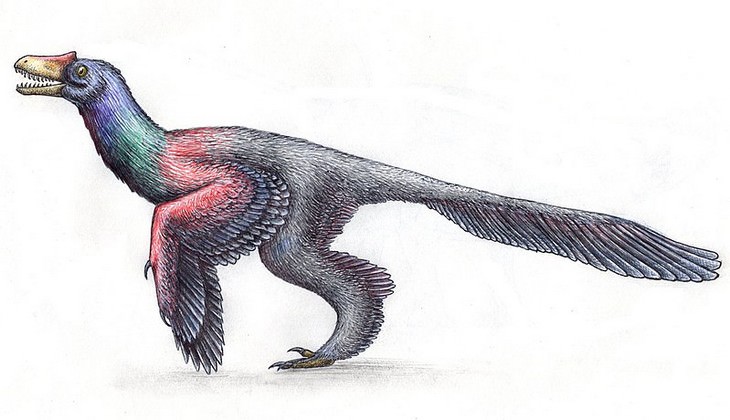1. Dinosaurs didn’t look like big lizards
It is now known that many dinosaurs had fluffy, colorful feathers. Paleontologists have found well-preserved fossils showing some dinosaurs had feathers all over their bodies and others just tufts of downy fluff. They’ve even been able to identify colors by studying tiny structures called melanosomes in the fossilized feathers. According to paleontologist Steve Brusatte, “Today’s birds evolved from dinosaurs, which makes them every bit as much of a dinosaur as T. rex or Triceratops,” which also means dinosaurs are not entirely extinct either, as most of us were taught.
2. George Washington didn’t have wooden teeth
While George Washington did have some serious dental problems, to the point he had one remaining tooth in his mouth by his inaugural address in 1789, he definitely did not have dentures made of wood. Rather, the dentures were made of ivory, gold, lead, and real teeth (probably from cows and horses and definitely from people). The origin of the wooden cavities myth remains unclear. The most likely explanation given by historians is that the ivory ingrained in the false teeth stained over time and gave them a wooden appearance that misled observers.
3. Women suspected of being witches were not burned at the stake
More than 200 people were accused of practicing witchcraft in colonial Massachusetts between 1692 and 1693, and 20 were executed. However, contrary to popular belief, no one was burned at the stake during the Salem witch trials. This brutal form of execution was practiced in Europe, but in England, they were hanged, and this is the tradition the colonists followed for all the victims, bar one who was crushed to death under stones.
Another myth regarding the Salem witch trials is that all the ‘witches’ were women. While it is indeed true that the great majority were female, 4 of the 20 executed in Salem were men.
4. Neanderthals were not inferior to modern humans
The belief that Neanderthals were hulking, unsophisticated cavemen is so deeply ingrained that the word became a synonym for someone thick or coarse and ill-mannered. But recent research uncovers that Neanderthals weren’t, in fact, much less intelligent than their cousin, Homo sapiens.
Cave paintings uncovered in Spain are estimated to be created by Neanderthals about 20,000 years before moderns humans arrived in Europe. They also used tools and made jewelry. So why did they go extinct? A 2017 study published in the journal Nature Communications suggests that they might simply have been outnumbered by the waves of Homo sapiens that filtered into their territory from Africa. It is impossible for two species that are so similar to coexist in the same ecological sphere without one changing or dying out.
5. Napoleon Bonaparte wasn’t that short
The truth is, the tiny conqueror was actually average height for his time - approximately 5 feet and seven inches or 170 cm. His reputation as a short man was probably due to satirical cartoons of him published in England, that depicted him as small, petty, and childish according to a 2016 column by Tristin Hopper in the Canadian newspaper the National Post. When Napoleon died, his height was documented as 5’2 (157 cm), but that was because of a difference between French and British units of measurement. However, this mistake fell in line perfectly with his reputation and went on to become a ‘fact’.
6. There isn’t such a thing as being left-brained or right-brained
According to the theory of left-brain or right-brain dominance, each side of the brain controls different types of thinking. So if you’re naturally more analytical, logical and objective you gotta be right-brained, while if you lean more towards creativity and subjectiveness you’re left-brained right? Well, wrong. While different parts of the brain definitely have different purposes, no studies were able to show different areas of brain activities in people with different personality traits. To learn more about the brain check out our previous article 11 Mind-Boggling Brain Facts.
7. There are more than three states of matter
Liquid, solid, and gas are the three most common states of matter here on earth, and the ones we learn about in school. However, beyond our atmosphere, there is a 4th state called plasma, and it may be the most widespread one in the universe. Put simply, plasma is an ionized gas, a gas into which sufficient energy is provided to free electrons from atoms or molecules and to allow both species, ions, and electrons, to coexist. Gases like neon are goaded into a plasma state by electricity to make glowing signs; stars are basically huge balls of plasma. But it turns out this is not the only extra state of matter.
In 1995, scientists created the Bose-Einstein condensate, a state in which matter is super-cooled to almost absolute zero, causing the molecular motion to practically stop. It is worth noting that while Bose-Einstein condensates can be made in a lab, no one knows whether that can exist in nature.
8. Chewing gum doesn’t take seven years to digest
No one knows exactly how this myth started, but it has been passed down through generations of school kids. Scientific American decided to find out if it’s true, and according to a Florida pediatric gastroenterologist named David Milov, the answer is absolutely not. He stated that while he does sometimes come across a hunk of chewed gum in the digestive tract during colonoscopies or endoscopies, “usually it’s not something that’s any more than a week old.” The truth is most gum passes right through the digestive system.
9. We use way more than 10 percent of our brains
It isn’t clear where the idea came from that 90% of our brain tissue goes unused, but any neurologist will tell you that’s definitely wrong. It’s been claimed that Einstein attributed his intellectual giftedness to being able to use more than 10 percent of his brain, but this is itself a myth. Another possible source of the 10 percent myth is neurosurgeon Wilder Penfield's discovery in the 1930s of "silent cortex" - brain areas that appeared to have no function when he stimulated them with electricity. In any case, today we know that these areas are functional, and brain scans show activity throughout the entire organ, even during sleep.
If you found this article interesting, share it with a friend









